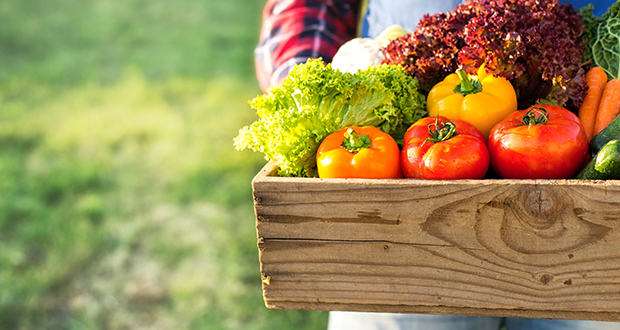Gut reactions: how dietary fibre interacts with the microbiome

The food we eat, particularly plant-based fibre, influences the composition and metabolic activity of the dense and diverse microbial community living in our guts, called the microbiome. This in turn has an impact on a number of health conditions. The interaction between dietary fibre and the microbiome is under the spotlight as it could offer an avenue to maintain or improve the microbiome.
TYPES OF FIBRE
Edible plants contain insoluble and soluble fibre, including cellulose, lignin and non-starch polysaccharides such as pectins. Insoluble fibre, found in foods such as wholegrain breads and cereals, wheatgerm, nuts, seeds and the skin of fruit and vegetables, is needed to add bulk to faecal matter and keep bowels regular. Soluble fibre, found in foods such as pulses, oats, fruit and vegetables, dissolves in water to form a thick gel in the intestines, slowing down digestion. Foods containing soluble fibre can help lower LDL-cholesterol, promote satiety and stabilise blood glucose levels.
Other dietary fibre components include non-digestible oligosaccharides such as inulin and oligofructose, as well as resistant starch, which is found in foods such as al dente pasta, under-ripe bananas, and cooked and cooled potatoes and grains.
Given their resistance to digestion in the small intestine, they pass largely intact into the colon where they increase the viscosity and bulking of faecal matter. They then undergo fermentation in the colon by the resident anaerobic caecal and colonic microflora into short-chain fatty acids (SCFAs), the fermentation end-product and primary carbon energy source for colonocytes, the epithelial cells of the colon.
It is thought resistant starch may have a positive impact on the stability and diversity of the microbiome; however, more research on humans is needed, as the specific effect of resistant starch has been observed as being highly variable between species and individuals.
The microbiome plays an important role in key nutritional, metabolic and immunological processes. Fibre affects the microbiome in a few ways, namely the overall composition, the intestinal bacteria-epithelial interactions, and the levels of SCFAs. Interruptions in its composition have been implicated in many diseases and disorders, including inflammatory bowel disease, obesity and diabetes. High luminal concentration levels of SCFA lower the colonic pH and inhibit growth of harmful bacteria, with the SCFA butyrate being shown to protect against the development of colitis and colorectal cancer.
IMPACT OF DIETARY CHOICES
Vegetarian and vegan diets high in dietary fibre from fruit, legumes, wholegrains and seeds are associated with greater microbial diversity, a reduced risk of constipation, diverticular disease, haemorrhoids, bowel cancer and cardiovascular disease, and a predominance of Prevotella over Bacteroides, a critical bacterium associated with a healthy microbiome.
Animal-based diets, Western-style diets that are high in fat and sugar and low in fibre, and the popular short-term rapid-weight-loss diets involving smaller intakes of low-fermentable carbohydrate/ fibre, decrease the beneficial bacteria needed to metabolise dietary plant-derived polysaccharides to SCFAs and increase mucosa-associated bacteria, which have a negative effect. This, alongside the increased abundance of Bacteroides, increases the risk of colonic disease.
Given that low-carbohydrate diets cause changes in the gut microbiome that could potentially have a negative impact on health, dietary intervention studies have shown that supplementation with dietary fibre can benefit the microbiome.
PREBIOTICS AND PROBIOTICS
Prebiotics, non-digestible dietary fibres found in foods such as aromatic vegetables, bananas, garlic, soybeans and green vegetables, benefit intestinal health by selectively stimulating the growth of a number of indigenous bacteria, especially Bifidobacterium and/or Lactobacillus. Benefits include enhanced gut mucosal barrier integrity and function, increased host mucosal immunity, and increased SCFAs production, reducing the mucosal interaction of opportunistic enteric pathogens.
Prebiotics work in conjunction with probiotics, active living microorganisms that are found in various food sources such as fermented milk drinks, yoghurt, cottage cheese and tempeh. Probiotics can also be obtained in supplement form, particularly for individuals opposed to dairy products. Both prebiotics and probiotics positively impact the microbiome.
MORE INFORMATION
The Australian Dietary Guidelines encourage people to eat a wide variety of high fibre foods such as fruit, vegetables and wholegrains. For further discussion about fibre intake and individualised advice, refer patients to an accredited practising dietitian.
 Visit www.daa.asn.au and search under ‘Find an accredited practising dietitian’ or freecall 1800 812 942.
Visit www.daa.asn.au and search under ‘Find an accredited practising dietitian’ or freecall 1800 812 942.
Katherine Baqleh is an accredited practising dietitian and nutritionist, and founder of Health Victory Nutrition Experts, a private practice and nutrition consultancy.
Katherine conducts private consultations, menu reviews and seminars and conferences in a number of community (such schools, rehabilitation centres, mothers groups, aged care centres) and corporate settings.
Email: [email protected]





